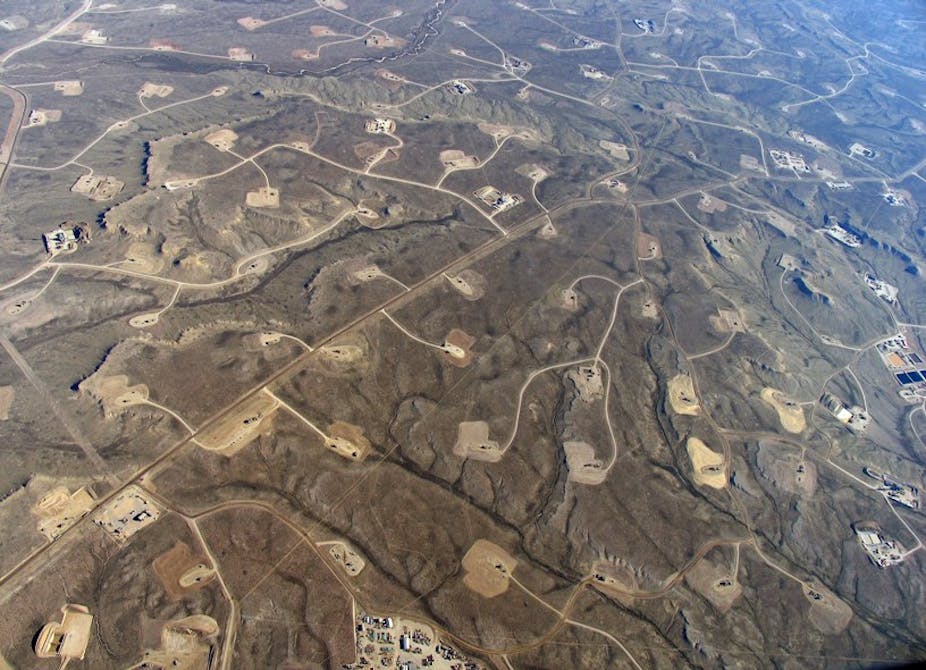The rise of hydraulic fracturing, or fracking, has ushered in an era of intense drilling that has been called the great shale gas rush. Fracking allows oil and natural gas to be extracted from horizontal wells, thousands of metres below the Earth’s surface. We tried to piece together the environmental impact of the great shale gas rush, and quickly discovered how little is actually known about the effects this booming industry is having on plants and wildlife.
To help shed light on this area where there is little research, we convened a team of eight scientists with diverse expertise in plants, birds, amphibians, mammals, wildlife disease, hydrology, and public policy. Our study, published in the journal Frontiers in Ecology and the Environment, examined 12 ways in which shale development can harm ecosystems. Using an objective ranking system, we identified the highest-priority threats for future research.
Much of the public debate around shale development has focused on the technique of fracking itself. The above-ground footprint of each well is relatively small at between 1.5-3 hectares of land cleared per well, but many are drilled in close proximity and each is connected by a labyrinthine network of roads and pipelines which must be built and in place before the fracking can start. This can add up to many thousands of hectares of disturbed land, contributing to habitat loss and fragmentation, generating light and noise pollution, and affecting air quality. The huge amounts of water required for fracking, on average 20m litres over the lifespan of a single well, can take a heavy toll on groundwater levels and water flow in streams, adding to siltation and affecting wildlife dependent on those habitats.
The whole process of drilling for oil and gas also provides opportunities for unpredictable and potentially disastrous events – chemical spills or pipeline ruptures – which pose high risks to surrounding ecosystems. Understanding these risks and effects is essential because many shale basins occur in regions of exceptional biological diversity. For example, the Devonian and Marcellus Shale in the Appalachian Basin overlap with the highest areas of amphibian and freshwater fish diversity in the United States.

Each of the threats we identified were assessed on their extent, duration, the difficulty of mitigating their effects, and the amount of relevant scientific information available. With limited resources, our top research priorities should be threats that are under-studied, widespread and whose effects take considerable time or effort to reverse. We found the highest risk and therefore highest research priorities were related to chemical contamination from spills, equipment failure, the movement of fluid underground, or storage leaks. Although our focus was on plants and wildlife, these problems could also affect human health.
More surprising was the lack of accessible and reliable information on the chemicals used in fracking (as part of the fracking fluid blasted underground to fracture the rock), spills, and the disposal of this fluid as wastewater. We reviewed the chemical disclosure statements provided by fracking companies for 150 wells in three of the top gas-producing states and found that, on average, two out of three wells were fracked with at least one undisclosed chemical, while some wells were fracked with 20 or more. It’s impossible to accurately predict the effects of environmental pollution if we do not know the identity and concentration of chemicals being released into soils and waterways.
Government and industry have made small steps towards openness, for example by creating the FracFocus registry and by maintaining regional databases. (for example the Pennsylvania Department of Environmental Protection). But these steps are not enough. Only five of the 24 US states involved in fracking – Pennsylvania, Colorado, New Mexico, Wyoming and Texas – maintain any public records of spills, and a lack of complete and consistent reporting is a major obstacle to understanding the environmental impact of shale development. For instance, less than half the reports in the Pennsylvania database included information on where spills occurred and fewer than one in 15 reports noted the date and time when the spill occurred. In fact, in Pennsylvania alone (an area about half the size of the UK), the Department of Environmental Protection cited companies 22 times in 2013 for discharging industrial waste into waterways.
The collective impact of shale development as illustrated above is not easily seen from the ground. Yet each modest-sized drilling operation contributes to at least 12 distinct environmental threats. The combined impact of these threats is itself a major research priority, but is exceptionally difficult to isolate and study.
With shale production projected to increase exponentially during the next 30 years, it’s vital that scientists, the industry and government regulators co-operate to minimise damage to the natural world. Scientists need access to reliable information about spills, violations, fluid disposal and chemicals used in fracking. This information must be seen as essential to prevent the shale industry from posing unacceptable risks to the living world, our families and communities.

